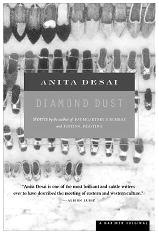“THE ARTIST’S LIFE,” a story from Anita Desai’s new collection Diamond Dust, features Polly, a young girl fresh from summer camp who realizes she’s an artist and that the “undeniable reality” of her house, yard, and suburb are “enemies, all, of Art.” Bored by her “pedestrian” tire swing, she joins her little brother in spying on Miss Dodd, the tenant who occupies a “two-roomed wooden cabin with a condemned porch and a sagging roof” in back of her house. Rumored to be a witch by the children, the peculiar Miss Dodd keeps to herself, allows kitchen waste to accumulate outside her abode, and has the audacity to invite a man over for a day. After Polly listens to Miss Dodd complain that someone used excrement to write ‘PIG’ across her car’s windows, she’s struck when her mother informs her that their tenant has taught art for 20 years: “[Polly’s] lips formed the letter ‘O’ or else ‘NO.’ She wanted to protest, she was not sure against what, but against something that had been presented to her, interposed between her and what she wanted and believed in—something objectionable, inadmissible, an imperfection.”
Diamond Dust
by Anita Desai (Mariner, $12)
Objections, trespasses, and imperfections abound in Desai’s nine stories whose characters find their preconceptions challenged by life’s complexities. In “Royalty,” Sarla is forced to delay her family’s annual retreat to the Himalayas thanks to a surprise visit from Raja, her highly spontaneous friend. In “Winterscape,” the American-born Beth wrestles with the news that her Indian husband has two mothers and that she’ll have to host these foreign village-dwellers for the duration of her pregnancy. The “decent, elderly civil servants” of “Diamond Dust” cluck their tongues at a man “portly and stiff as any of them, romping ridiculously in a rose garden” with the unpopular dog that is—to his wife’s chagrin—the love of his life. In Diamond Dust, those who adapt grow; those who can’t are only human.
As the daughter of a German mother and a Bengali father—as well as one of the few leading Indian authors to write in English—it’s fitting that Desai refuses to set her stories in one geographical locale. The tales take place in Bombay, New England, a road in the middle of India, a village just outside Mexico City. Their ways of unfolding are just as varied: “The Man Who Saw Himself Drowned” contains an experimental narrative reminiscent of Dostoevsky’s “The Double”; “Underground” is a morbid love story, ripe with symbolism; and “The Rooftop Dwellers,” the most charming of the collection, relays the comic struggles of a young professional woman coming of age in New Delhi. In all these stories, whatever the characters’ nationalities, dilemmas, or gender, Desai uses simple yet loaded language to pen a portrait of humankind, with hopes and disappointments as backdrop—and she does so with a touch of greatness.








